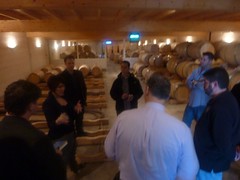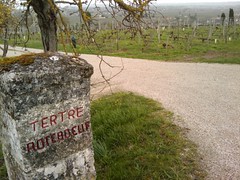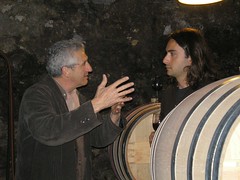The mission begins: Ch. Haut-Brisson & Tertre Roteboeuf
Post by Andy Frieden | Saturday, March 27th
Following a good night's sleep after our turbulent flight from SFO, we set out on the road for our first look at the 2009 Bordeaux vintage. Hitting the Right Bank in a convoy of three rental cars, Saturday began auspiciously with a negociant tasting (see John Perry's post "Pack Your Good Liver" for that adventure!), followed by visits to Chateau Haut Brisson and the venerable Chateau Tertre Roteboeuf.

- Tasting in the barrel room at Ch. Haut Brisson
First stop: Chateau Haut Brisson in St. Emilion. On a roll of late with their "La Reserve" garnering accolades from Robert Parker, the main vineyard for Chateau Haut Brisson shares the same gravel soil profile with Chateau Monbousquet. Since employing Michel Rolland as consulting winemaker, the winery has grown from their initial eight hectares to 13, with plans to purchase three additional hectares in St. Emilion in just a few months.
The vineyard is planted to about 80% merlot, 15% cabernet sauvignon and 5% cabernet franc. Three cuvees are produced here - an entry level wine called "Les Graves," the estate blend Chateau Haut Brisson, and the "La Reserve". We tasted three vintage verticals of each of these wines and each perfectly represented Right Bank terroir, with dark purple color pretty perfume of black fruits and some crushed flower blossoms along with Michel Rolland's signature silky texture.
I had an interesting discussion with the director of the Chateau, focusing on how soil profiles affect flavors and texture in wine. Haut Brisson has three distinct soil profiles and each leaves its mark in the finished product. Gravel rocky soil seems to impact flavors and aromas, giving rise to graphite, fresh pavement, and pencil lead notes, whereas sandy soil imparts power and clay soils give rise to a wine's density.

- Tertre Roteboeuf
Our next stop was at Tertre Roteboeuf where we met owner and winemaker Francois Mitjaville, a true Renaissance man and one you are not likely to forget having met. As we arrived, a sudden rain shower halted our plans for a vineyard walk, so Francois ushered us inside to a parlor room filled with antiquities and a coffee table stacked high with art books. We sat for awhile and listened as he spoke fervently about the emotional aspects of winemaking, contrasting this with what he sees as a focus on making powerful wines by the "new guard" of Bordeaux winemakers. His philosophy and passion for both wine and life are as captivating as the 150 year old paintings that adorn his walls.
Francois looks at wine from a completely different perspective than any vintner I have met in my 20 years in the business. He calls his philosophy of winemaking 'emotional', again in contrast with a 'power' approach. His young wines aren't super dark, black, or inky purple in color. Rather, they are more ruby red or mahogany, with a savory perfume and soft tannins. He makes wine that reveals the terroir of each vintage and allows the wines to express this terroir as naturally as possible with little manipulation.
Two wines are made at Tertre Roteboeuf, the estate wine being the Chateau labeling and a Cote de Bourg wine called 'Roc de Cambes'. The estate vineyard is on the backside of the Pavie Hill, protected from the north and westerly winds that come with cold and wet weather. This sweet spot offers a gentle, even growing season and allows for a harvest two weeks later than his neighbors. Both wines show a more feminine finesse and possesses nuances rarely seen in a Right Bank wine today.

- Francois Mitjaville shows Alex Lallos how to gesture in French.
As we began our tasting, I noticed that his wines are indeed lighter in color as Francois indicated. The delicate perfume and the body and texture of his wines alludes more to a fine Grand Cru Burgundy than the dark, inky purple color of wines made in the modern Right Bank style. They are distinctly delicate, supple and fleshy in the mid-palate. Francois says he has no problem with lighter color and thinks nothing of what anyone says about the choices he makes in producing his wines. This is in direct opposition to the prevailing trend toward dense powerful wines that get the attention of wine writers. Francois refers to his wines as 'rustic' and certainly there is a certain spicy savory component of dried tobacco leaf and black tea, along with an earthy truffle note.

- Tertre Roteboeuf vineyard, backside of Pavie Hill
We tasted the 2008 and 2009 vintages of both wines. The '08's are showing great now and will be bottled in August. The 2009's are more powerful and just finished primary fermentation eight days ago! All of Francois's wines have a silky texture to them that is alluring and provides a refreshing alternative to wines that are darker in color. As a treat, Francois went into his cellar and brought out a 1985 vintage to show us how well his wines age. This 24-year old wine is still showing a vibrant ruby red color with Francois' signature savory bouquet of fresh red currant, cigar tobacco and tea leaf with subtle notes of cedar, saddle leather, and black truffle. The palate was surprisingly fresh and juicy with a core of cherry fruit along with cigar box and earthly truffles and an absolutely fantastic way to conclude our visit here. Cheers!